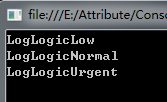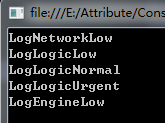首先来看一下微软官方对Attributes(C#)的定义:
https://docs.microsoft.com/en-us/dotnet/csharp/programming-guide/concepts/attributes/index
Attributes provide a powerful method of associating metadata, or declarative information, with code (assemblies, types, methods, properties, and so forth). After an attribute is associated with a program entity, the attribute can be queried at run time by using a technique called reflection. For more information, see Reflection (C#).
Attributes have the following properties:
-
Attributes add metadata to your program. Metadata is information about the types defined in a program. All .NET assemblies contain a specified set of metadata that describes the types and type members defined in the assembly. You can add custom attributes to specify any additional information that is required. For more information, see, Creating Custom Attributes (C#).
-
You can apply one or more attributes to entire assemblies, modules, or smaller program elements such as classes and properties.
-
Attributes can accept arguments in the same way as methods and properties.
-
Your program can examine its own metadata or the metadata in other programs by using reflection. For more information, see Accessing Attributes by Using Reflection (C#).
这段英文很简单,我们可以Get到如下几个点:
1,Attributes可以向你的程序中添加元数据。元数据是指你在程序中定义的类型的信息,所有的.net程序集都包含了一组描述定义类型以及类型成员的元数据。
2,可以添加一到多个Attribute到程序集,模块或者类。
3,Attributes可以接受参数。
4,程序可以利用反射来检查自己的元数据。
我们先抛开反射,看Attributes的定义,感觉Attributes像是在描述一个类:可以添加成员变量,可以写入元数据,可以接受参数。
而当我们使用的时候,需要这样写:
[DllImportAttribute("xxx,dll")]
或者这样
[DllImport("xxx.dll")]
注意,这里都没有分号。如果你还有特殊需求的话,可以写上可选参数,比如:
[DllImport("xxx.dll", ExactSpelling=false, SetLastError=false)]
我们可以看到这里语法有些怪异,首先是方括弧的使用,其次是函数参数的赋值上,如果我们需要写入赋值的参数名,往往会这么写:ExactSpelling : false。最后当我们使用Attributes的时候, 它附着的地方也很奇怪,看上去不像是类或者方法的一部门,但却能对类或者方法产生影响。
下面我们写一个系统自带的Attributes的范例:
假设我们有一个日志系统,分布在代码各处,主要分为3大类:网络日志(输出网络回调的各种状态),游戏内逻辑日志(用于调试信息),引擎底层日志(比如我们重写了UGUI)。日志的等级分为低等级,普通,紧急三种状态。
我们使用同一个日志管理系统来输出对应的日志。现在我希望能够过滤固定类型的日志,并且每次更改过滤条件的时候尽可能少地改动代码。这个案例在这里可能并不恰当,过滤日志的话还有很多更好更快的代码,这里仅做参考。
public class ToolKit { /// <summary> /// 网络日志 /// </summary> [Conditional("Network")] [Conditional("Low")] public static void LogNetworkLow() { Console.WriteLine("LogNetworkLow"); } [Conditional("Network")] [Conditional("Normal")] public static void LogNetworkNormal() { Console.WriteLine("LogNetworkNormal"); } [Conditional("Network")] [Conditional("Urgent")] public static void LogNetworkUrgent() { Console.WriteLine("LogNetworkUrgent"); } /// <summary> /// 逻辑日志 /// </summary> [Conditional("Logic")] [Conditional("Low")] public static void LogLogicLow() { Console.WriteLine("LogLogicLow"); } [Conditional("Logic")] [Conditional("Normal")] public static void LogLogicNormal() { Console.WriteLine("LogLogicNormal"); } [Conditional("Logic")] [Conditional("Urgent")] public static void LogLogicUrgent() { Console.WriteLine("LogLogicUrgent"); } /// <summary> /// 引擎日志 /// </summary> [Conditional("Engine")] [Conditional("Low")] public static void LogEngineLow() { Console.WriteLine("LogEngineLow"); } [Conditional("Engine")] [Conditional("Normal")] public static void LogEngineNormal() { Console.WriteLine("LogEngineNormal"); } [Conditional("Engine")] [Conditional("Urgent")] public static void LogEngineUrgent() { Console.WriteLine("LogEngineUrgent"); } }
首先我们定义了一个ToolKit的类,里面有诺干静态函数,每个静态函数负责输出特定的日志(请无视这垃圾代码)。在每个函数上面,我们加了类似条件的东西。Conditional是系统定义的一个Attribute,作用是过滤条件。这段代码很好看懂,只是语法让人觉得有点诡异。
接着我们在主程序中,把所有输出都打印一遍。
static void Main(string[] args) { ToolKit.LogNetworkLow(); ToolKit.LogNetworkNormal(); ToolKit.LogNetworkUrgent(); ToolKit.LogLogicLow(); ToolKit.LogLogicNormal(); ToolKit.LogLogicUrgent(); ToolKit.LogEngineLow(); ToolKit.LogEngineNormal(); ToolKit.LogEngineUrgent(); Console.ReadKey(); }
执行程序,然而什么输出也没有。这说明我们设置的条件生效了。接下来我们在CS文件头上加入#define Normal。

似乎和我们的预期相同。把#define Normal改为#define Logic,再次运行。

完美。现在我想输出低等级的网络日志,在原来的#define Logic下面再加入一行#define Low,然后运行。

Oops,条件筛选似乎用了或而没用与。这里是一个需要注意的点,如果一定要用与条件筛选的话,可以用#if语句做条件判定,这里不再赘述了。
至此,我们对Attributes的使用有了一个初步的认识。下一讲,我们将对Attributes的原理进行剖析。